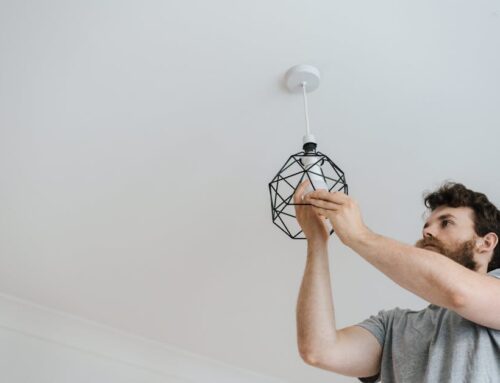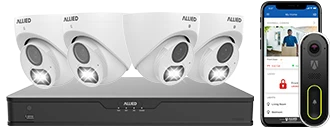Introduction to Home Alarm Monitoring Systems
Home alarm monitoring systems have become a crucial component in ensuring the security of residential properties. These systems provide a layer of protection that goes beyond traditional locks and alarms, offering real-time surveillance and immediate response to security breaches.
The primary function of home alarm monitoring systems is to detect unauthorized entry or suspicious activities in and around the home. When the system senses an unusual event, it triggers an alarm and sends alerts to the homeowner and the monitoring center. This ensures that action can be taken promptly, whether it’s notifying law enforcement, dispatching a security team, or alerting emergency services.
The importance of home alarm monitoring systems is underscored by crime statistics. According to the Federal Bureau of Investigation (FBI), in 2019 there were an estimated 1,117,696 burglaries in the United States, resulting in significant property losses. Homes without security systems are up to 300% more likely to be broken into, as reported by the National Council for Home Safety and Security. These figures highlight the critical role home alarm monitoring systems play in deterring potential intruders and reducing the risk of theft and vandalism.
Moreover, home alarm monitoring systems are continuously evolving to include a range of advanced features. These may include motion detectors, glass break sensors, environmental sensors (such as smoke or carbon monoxide detectors), and surveillance cameras. Such comprehensive systems not only enhance security but also provide peace of mind for homeowners.
Despite their benefits, it is also essential to recognize that home alarm monitoring systems require careful consideration regarding costs, installation, and maintenance. The goal is to ensure that the system is effective, reliable, and fits within the homeowner’s budget.
In summary, home alarm monitoring systems serve as a robust defense mechanism against unauthorized access and potential hazards. They play a vital role in providing a safe and secure living environment, reflecting their value in modern home security strategies.
Key Features of Modern Home Alarm Systems
Modern home alarm systems offer a variety of features designed to enhance security and provide peace of mind. Understanding these key features is essential to make an informed decision when selecting a home alarm system.
Wireless Technology
Wireless alarm systems eliminate the need for extensive wiring, making installation easier and less invasive. These systems rely on radio frequencies to communicate between devices, ensuring a seamless connection even in larger homes.
Smartphone Integration
Many home alarm systems now offer smartphone integration, allowing homeowners to monitor and control their systems remotely. Through dedicated mobile apps, users can receive real-time alerts, arm or disarm the system, and even view live video feeds from security cameras.
24/7 Professional Monitoring
24/7 professional monitoring services ensure that emergency signals are responded to promptly. When an alarm is triggered, the monitoring center can verify the threat and contact emergency services if necessary, providing an additional layer of security.
Video Surveillance
Video surveillance has become a critical component of modern home alarm systems. High-definition cameras, night vision capabilities, and cloud storage options allow homeowners to capture and review footage in case of an incident.
Environmental Sensors
Beyond intrusion detection, modern systems also include environmental sensors that monitor hazards such as smoke, carbon monoxide, and water leaks. These sensors provide early warnings, helping to prevent damage and ensure the safety of occupants.
Home Automation Integration
Integrating with home automation systems, modern home alarms can coordinate with other smart devices. This allows for enhanced functionality, such as automatically locking doors, adjusting thermostats, or turning on lights in response to security events.
Localized Alerts
Localized alerts, such as audible alarms or flashing lights, can deter intruders and alert occupants to potential threats. These alerts are an essential part of any home alarm system, providing an immediate response to a security breach.
Battery Backup
Battery backup ensures that the alarm system remains operational during power outages. This feature is crucial for maintaining security even when utility services are disrupted.
Customizable Zones
Home alarm systems often support customizable zones, allowing homeowners to designate specific areas for monitoring. This customization enables more precise surveillance, focusing security efforts where they are needed most.
By understanding these key features, homeowners can better evaluate their options and choose a home alarm system that meets their specific needs.
Types of Monitoring Services Available
When it comes to home alarm monitoring services, homeowners have several options to choose from, each with distinct features, benefits, and considerations. Understanding the different types of monitoring services available can help you make an informed decision that best suits your needs and budget.
1. Professional Monitoring Services
Professional monitoring services involve a third-party company that monitors your home security system around the clock. These services typically come with a monthly fee and offer several advantages:
- 24/7 Surveillance: The monitoring center is staffed with security professionals who can respond to alerts at any time, day or night.
- Emergency Response: If an alarm is triggered, the monitoring center can quickly contact emergency services like the police, fire department, or medical responders.
- Peace of Mind: Knowing that professionals are constantly monitoring your home prov
ides an added layer of security and reassurance.
2. Self-Monitoring Services
Self-monitoring services put the responsibility of monitoring your home security system into your own hands. These systems often use smartphone apps to send alerts and notifications directly to you:
- Cost-Effective: Self-monitoring systems usually have lower upfront costs and do not require monthly fees for professional monitoring.
- Real-Time Alerts: Receive notifications on your smartphone instantly, allowing you to respond to alarms quickly.
- Control and Customization: Self-monitoring gives you greater control over system settings and responses to alerts.
3. Hybrid Monitoring Services
Hybrid monitoring services offer a combination of professional and self-monitoring features. These systems typically allow you to monitor your home yourself while also having the option to switch to professional monitoring when needed:
- Flexibility: Users can choose between self-monitoring and professional monitoring based on current needs and circumstances.
- Backup Support: Professional monitoring can act as a backup if you are unable to respond to alerts.
4. Landline Monitoring
Landline monitoring involves using a traditional phone line to connect your home security system to the monitoring center:
- Reliability: Landline monitoring is considered reliable because it does not depend on internet connectivity.
- Vulnerability: Landlines can be physically cut, potentially disabling the alarm system.
5. Cellular Monitoring
Cellular monitoring uses a cellular network to communicate with the monitoring center, offering several benefits:
- Independence from Landlines: Eliminates the risk of cut phone lines, making it a more secure option.
- Remote Accessibility: Can be accessed and controlled from anywhere using a smartphone app.
6. Broadband Monitoring
Broadband monitoring uses your home’s internet connection to send alerts and notifications to the monitoring center:
- High-Speed Communication: Faster than landline connections for sending emergency alerts.
- Dependency on Internet: Reliant on a stable internet connection, which could be a drawback if your service is unreliable.
The Role of Technology in Home Security
In the realm of home security, technology plays a pivotal role in enhancing the effectiveness and efficiency of alarm monitoring systems. Technological advancements have introduced a wide range of sophisticated tools and functionalities that contribute to the overall safety of residential properties. Understanding the role of technology in home security is essential for appreciating the capabilities of contemporary home alarm monitoring systems.
Integration with Smart Home Devices
Modern home alarm systems are often integrated with smart home devices, allowing homeowners to control and monitor their security systems remotely using smartphones, tablets, or computers. This integration ensures seamless communication between various devices such as cameras, motion detectors, and door sensors, thereby offering a comprehensive security solution.
Wireless Technology
Traditional alarm systems relied heavily on wired connections, which could be susceptible to tampering. Contemporary home alarm systems utilize wireless technology to eliminate this vulnerability. Wireless systems are easier to install and can be more flexible in terms of placement, reducing the likelihood of a security breach.
Mobile Applications
Mobile applications have become integral to home alarm monitoring, providing real-time alerts and remote access to the system. These applications enable homeowners to arm or disarm their systems, view live camera feeds, and receive instant notifications of any unusual activity. The convenience of mobile access adds an extra layer of security, as homeowners can monitor their property from anywhere.
Artificial Intelligence and Machine Learning
Artificial Intelligence (AI) and Machine Learning (ML) are increasingly being utilized in home security systems to enhance their responsiveness and accuracy. These technologies can analyze patterns and detect anomalies more effectively than traditional systems. For example, AI-powered cameras can differentiate between regular movements and potential threats, reducing false alarms and improving response times.
Cloud Storage
Cloud storage solutions play a crucial role in modern home alarm systems by securely storing video footage and other data remotely. This ensures that important evidence is preserved even if the physical security equipment is damaged or stolen. Cloud storage also allows for easy access and sharing of data with law enforcement agencies when necessary.
Advanced Sensors and Detectors
Advancements in sensor technology have led to the development of more sensitive and reliable detectors. Modern sensors can detect various threats, including smoke, carbon monoxide, and break-ins, with higher accuracy. These sensors are often part of an integrated system that communicates with the central monitoring station to respond promptly to emergencies.
In summary, technology significantly enhances the capabilities of home alarm monitoring systems through integration with smart devices, wireless technology, mobile applications, AI and ML, cloud storage, and advanced sensors. These technological advancements collectively contribute to more reliable and efficient home security, ensuring better protection for residential properties.
Benefits and Drawbacks of Home Alarm Monitoring
Home alarm monitoring offers a range of both benefits and drawbacks that should be carefully evaluated by homeowners considering these systems for their properties. By examining these aspects, individuals can make more informed decisions about whether home alarm monitoring aligns with their safety needs and lifestyle.
Benefits of Home Alarm Monitoring
Enhanced Security: One of the primary benefits of home alarm monitoring is the increased level of security. Having a monitored system ensures that emergency services can be quickly alerted in the event of a break-in, fire, or other emergencies. This rapid response can significantly reduce the risk of extensive property damage or personal harm.
24/7 Surveillance: Most home alarm monitoring services offer round-the-clock surveillance, providing homeowners with peace of mind knowing their property is being watched continuously. This is especially useful for individuals who travel frequently or spend long hours away from home.
Insurance Discounts: Many insurance companies offer discounts on home insurance premiums for homes equipped with monitored alarm systems. These savings can help offset the costs of the monitoring service over time.
Deterrent Effect: Visible signs of home alarm systems and secure monitoring can act as a significant deterrent to potential intruders, who are less likely to target a home they know is protected by a monitored system.
Drawbacks of Home Alarm Monitoring
Cost: One of the main drawbacks of home alarm monitoring is the cost. Homeowners must pay for both the initial installation of the system as well as ongoing monthly fees for the monitoring service. These costs can add up over time, making it a significant financial commitment.
False Alarms: False alarms can be a common issue with home alarm systems. These can be caused by various factors, including user error, system malfunctions, or environmental factors like strong winds or animals. Frequent false alarms can not only be a nuisance but can also result in fines from local authorities if emergency services are dispatched unnecessarily.
Privacy Concerns: Some homeowners may feel uneasy about the constant monitoring of their property, and there are potential privacy concerns related to the data collected by monitoring systems. It’s important to understand the terms of service and know how your data will be used and protected by the monitoring company.
Maintenance Requirements: Home alarm monitoring systems require regular maintenance to ensure they function properly. This can involve periodic testing, software updates, and battery replacements for wireless components, which can be an additional responsibility for homeowners.
Conclusion
While home alarm monitoring provides numerous security benefits and can potentially lower insurance costs, it also involves recurring expenses and other considerations such as privacy and maintenance requirements. Prospective users should weigh these factors based on their specific needs, budget, and lifestyle to make the best choice for safeguarding their home.
Future Trends in Home Alarm Monitoring
As technology continues to advance, the field of home alarm monitoring is poised for significant changes. Several emerging trends are expected to shape the future of home security systems, offering enhanced capabilities and improved user experiences.
Smart Home Integration: One of the most notable trends is the integration of home alarm systems with other smart home devices. This seamless connectivity allows homeowners to control various aspects of their security setup through a central interface or even via voice commands. Integration with smart locks, lights, and cameras can provide a comprehensive home security solution that is more intuitive and user-friendly.
Artificial Intelligence and Machine Learning: AI and machine learning technologies are being increasingly incorporated into home alarm monitoring systems. These technologies can analyze patterns and behaviors to differentiate between false alarms and genuine threats more accurately. Over time, AI can learn the daily routines of household members, further reducing the likelihood of false alerts and ensuring a more reliable security system.
Enhanced Video Analytics: Advances in video analytics are another promising trend. More sophisticated software can now analyze video feeds in real-time, identifying unusual activities or potential intrusions based on predefined criteria. This can significantly improve the effectiveness of surveillance systems and provide more timely and accurate alerts.
Mobile App Integration: Increased mobile app compatibility is another key trend. Modern alarm systems often offer mobile apps that enable users to monitor and control their home security from anywhere. Features such as real-time notifications, remote arming/disarming, and live video feeds provide homeowners with enhanced peace of mind and convenience.
Cloud-Based Solutions: The adoption of cloud-based technologies is also on the rise in the home security sector. Cloud storage offers secure and scalable options for saving video recordings and other data, ensuring that crucial information is accessible even if local storage devices are compromised. Additionally, cloud-based systems can facilitate software updates and new feature rollouts without requiring substantial hardware changes.
5G Connectivity: The rollout of 5G networks promises to enhance the capabilities of home alarm monitoring systems by providing faster and more reliable connectivity. This improvement can support high-resolution video streaming and real-time alerts, making security systems more responsive and effective.
Environmental Monitoring: Future home security systems are likely to include more comprehensive environmental monitoring. Sensors for detecting smoke, carbon monoxide, water leaks, and even air quality can be seamlessly integrated into alarm monitoring systems, providing a holistic approach to home safety.
In conclusion, the future of home alarm monitoring looks promising, with the widespread adoption of advanced technologies enhancing the capabilities and user experience of home security systems. These innovations are set to provide homeowners with more efficient, intelligent, and reliable ways to protect their homes and loved ones.












